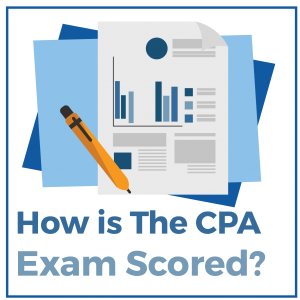
The system used for scoring the CPA exam may be confusing if you are unfamiliar with the methods followed by the American Institute of CPAs (AICPA), Prometric, or the NASBA.
Therefore, it’s a good idea to spend a little time to understand the principles that are adopted in the scoring process and to become familiar with the terminology and procedure used to arrive at your final score.
See the Top CPA Review Courses
- Becker CPA Review Course ◄◄ #1 Rated CPA Prep Course of 2025
- Surgent CPA Prep Course ◄◄ Best Adaptive Technology
- Gleim CPA Review Course ◄◄ Most Practice Questions
CPA Exam Passing Score Requirements
There are four sections to the CPA exam, and you must score a minimum of 75 (on a scale of 0 to 99) to pass in each.
| Section | Range of Possible Scores | Minimum Score Required To Pass |
| Auditing and Attestation (AUD) | 0 – 99 | 75 |
| Business Environment and Concepts (BEC) | 0 – 99 | 75 |
| Financial Accounting and Reporting (FAR) | 0 – 99 | 75 |
| Regulation (REG) | 0 – 99 | 75 |
The score is often misinterpreted in several ways. Hence, at the very outset you should know that:
⇨ It is not a raw score – your CPA exam score is not just the number of questions that you got right. Therefore, if there were, say, 50 questions, and you answered 28 correctly, your raw score would be 28. In actual practice, the number of correct answers that you provide only forms the basis for calculating your final score.
⇨ It is not a percentage – if we consider the same example as provided above, a raw score of 28 out of 50, expressed as a percentage, is 56%. [28/50 X 100 = 56%]. However, the CPA exam score is not a percentage. If you receive a passing score of 80, it doesn’t mean that you answered 80% of the questions correctly.
⇨ The score is not graded on a curve – grading on a curve implies that an average score is calculated for the individuals who take an exam, and everybody’s scores are compared with this average. In effect, if scores are graded on a curve, a candidate is competing with other test takers. CPA exam scores are not computed in this manner.
Therefore, if your CPA score is not a raw score, not a percentage, and not graded on a curve, how exactly is it arrived at?
Your CPA exam score is a weighted combination of your scaled scores
You can get a score that ranges from 0 to 99 in each of the four sections of the CPA exam. The scores are calculated using a weighted combination of scaled scores from each of the portions in the different sections of the exam.
Which are the different portions in each section and what are the weights allotted to them?
| Section | Portion – Multiple-choice questions (MCQs) | Portion – Task-based simulations (TBSs) | Portion – Written communication tasks | Total |
| Section – Auditing and Attestation (AUD) | 50% | 50% | n/a | 100% |
| Section – Business Environment and Concepts (BEC) | 50% | 35% | 15% | 100% |
| Section – Financial Accounting and Reporting (FAR) | 50% | 50% | n/a | 100% |
| Section – Regulation (REG) | 50% | 50% | n/a | 100% |
This table indicates that the Auditing and Attestation (AUD) section is divided into two portions – Multiple-choice questions (MCQs) and Task-based simulations (TBSs). Each has a weight of 50%.
Similarly, Financial Accounting and Reporting (FAR) and Regulation (REG) are divided into two portions, each of which has equal weight. Only Business Environment and Concepts (BEC) has three portions – MCQs (50%), TBSs (35%), and Written communication tasks (15%).
Remember that the percentages mentioned above represent the weight for each portion. Hence, this weight is applied to the scaled score that you get.
Now, what is a scaled score and how is it calculated?
The purpose of using a scaled score is to make the score used for different versions of the CPA exam comparable. Some questions may be more difficult than others. Therefore, it is possible to standardize the exam results by using statistical processes to calculate test scores that allow the results from different sets of questions to be compared.
The scaled value that is obtained by using a statistical formula converts the raw score into a different figure. Due to this reason, it is not possible to compute your score in a particular section of the CPA exam by adding the number of questions that you answered correctly. The formula to calculate the scaled score takes various factors into account. These include:
- Whether you answered the correction correctly or not.
- The relative difficulty of the question.
Understanding the multi-stage adaptive test delivery model
The scoring system in the CPA exam has another feature that you should be aware of. The Multiple-choice questions (MCQ) portion of the different sections uses a multi-stage adaptive test delivery model.
This is a scoring procedure that involves a variation in the difficulty of questions that are allocated to candidates. To understand how this works, let us first view the examination structure for each section of the CPA exam:
Learn More About The CPA Exam
- The Ultimate Guide To The Audit Exam
- CPA Salary Guide: How Much Can You Make?
- CPA Exam Sections & Testing Windows
- 43 FAQ's for CPA's
- Top International Destinations to Take the CPA Exam
CPA Exam Sections & Structure
| Section | Item Types | Testlet* |
| Auditing and Attestation (AUD) | 72 Multiple-choice questions 8 Task-based simulations |
No. 1: 36 MCQs No. 2: 36 MCQs No. 3: 2 TBSs No. 4: 3 TBSs No. 5: 3 TBSs |
| Business Environment and Concepts (BEC) | 62 Multiple-choice questions 4 Task-based simulations 3 Written communication |
No. 1: 31 MCQs No. 2: 31 MCQs No. 3: 2 TBSs No. 4: 2 TBSs No. 5: 3 Written communication |
| Financial Accounting and Reporting (FAR) | 66 Multiple-choice questions 8 Task-based simulations |
No. 1: 33 MCQs No. 2: 33 MCQs No. 3: 2 TBSs No. 4: 3 TBSs No. 5: 3 TBSs |
| Regulation (REG) | 76 Multiple-choice questions 8 Task-based simulations |
No. 1: 38 MCQs No. 2: 38 MCQs No. 3: 2 TBSs No. 4: 3 TBSs No. 5: 3 TBSs |
Note:
1.*A Testlet is a part of the section.
2. 4 hours are provided for the completion of each section
You will see that each section has a large number of Multiple-choice questions divided into two testlets. Testlet number 1 in the Auditing and Attestation section has 36 Multiple-choice questions, and testlet number 2 in the same section has another 36 Multiple-choice questions. Similarly, the other three sections have two testlets of Multiple-choice questions each.
Testlet number 1 in each of the sections is always a medium testlet. This means that the questions in it are of a medium level of difficulty. If you perform well in the first testlet, then the second testlet that is allocated to you will be of a higher level of difficulty. However, if you do not perform well, your second testlet will also be of medium difficulty.
Why does the CPA exam follow this multi-stage procedure? And how does it affect the scores of CPA candidates? If you get a more difficult testlet, won’t you find it harder to answer correctly?
The reason for following this system is that it allows the candidate’s proficiency level to be measured more accurately. It should be noted that a difficult testlet would not result in a lower score. That’s because the characteristics of the test are taken into consideration when awarding a score.
The multi-stage adaptive model is used only for the Multiple-choice question portion of the exam. It is not used for Task-based simulations or written communication tasks.
Get The Best Discounts On Your CPA Review Course!

Enjoy $1,050 Off Gleim CPA Premium Pro Course

Becker CPA: Interest-Free Payment Plan – Deal

Becker Deal: Save on CPA Single Part Courses
What are CPA exam pretest questions?
Every exam includes pretest questions. These are questions that are used by Prometric, NASBA, and AICPA to collect data and scoring information for later use. The score that you get on pretest questions does not form part of the final score release for your CPA exam.
Each section has 12 pretest Multiple-choice questions and one pretest Task-based simulation. Furthermore, the Business Environment and Concepts section also includes one pretest written communication task.
How can you tell a pretest question from a regular one? You can’t. Hence, it’s advisable to treat all the parts of the exam equally and try to answer each question as best as you can.

Is the CPA exam scoring automated or do humans score the exam?
The scoring for every section of the CPA exam except the written communication tasks is completely automated. Candidate performance on a majority of the written communication responses is scored by a computer grading program that is closely monitored by human scorers.
The score release process has many checks and balances built into it to ensure absolute fairness. For example, if a candidate falls short of the passing score by a small margin, the written communication portion of the exam is re-graded by human scorers.
The bottom line
The CPA exam is conducted in a meticulous and painstaking manner. A great deal of effort goes into ensuring that the questions for the exam are prepared and graded carefully.
Three highly reputed institutions are involved in the process of evaluating prospective Certified Public Accountants. These are the AICPA, the National Association of State Boards of Accountancy (NASBA), and Prometric, a company that delivers the exam at its authorized centers.
However, this does not mean that it is easy to understand how well you have scored in the exam. In fact, the entire exam procedure is a complex system, a black box of sorts, and it can sometimes be hard to correlate your score with your performance in the exam. For example, you could have done well in the pretest questions, but these don’t count towards your final score.
What is the recourse that you have if you don’t think your score accurately reflects how well you did in the exam?
In this situation, you can opt for a score review or an appeal.
Score Review – this is not a re-grading of your exam. It is merely an “independent verification of your exam score.”
The review involves ascertaining that the correct answer key was used for the Multiple-choice questions and the Task-based simulations. As regards the written communication tasks, the review verifies that each of these was scored.
Appeal – an appeal is more complicated and is not available in every jurisdiction where the test is held. If you decide to appeal against the score that you have been given, you will be provided with the opportunity to view the Multiple-choice questions and the Task-based simulations to which you gave an incorrect response. You will be provided with the opportunity to submit comments online. However, the written communication tasks are excluded from the appeal process.
Is it worthwhile to opt for a score review or to go in for an appeal? In most instances, you would be better off simply retaking the exam. A vast majority of review requests and appeals are unsuccessful.
Now that you know about the CPA exam scoring process, take a look at our article on testing windows. Alternatively, you can check out our picks for the best CPA review courses below!
Compare the Best CPA Review Courses
How Is The CPA Exam Scored? Frequently Asked Questions |
|---|
| What is passing score for CPA exam?
|
| How is CPA exam scored?
|
| Is the CPA exam curved?
|
| Which CPA exam is the hardest?
|


